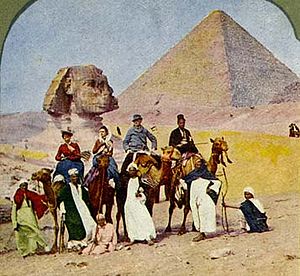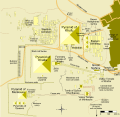
Giza Necropolis
Background Information
SOS Children volunteers helped choose articles and made other curriculum material A quick link for child sponsorship is http://www.sponsor-a-child.org.uk/
| Memphis and its Necropolis - the Pyramid Fields from Giza to Dahshur | |
|---|---|
| Name as inscribed on the World Heritage List | |
 |
|
| Country | |
| Type | Cultural |
| Criteria | i, iii, vi |
| Reference | 86 |
| UNESCO region | Egypt |
| Inscription history | |
| Inscription | 1979 (3rd Session) |
The Giza Necropolis stands on the Giza Plateau, on the outskirts of Cairo, Egypt. This complex of ancient monuments is located some 8 km (5 mi) inland into the desert from the old town of Giza on the Nile, some 25 km (15 mi) southwest of Cairo city centre. The Great pyramid is the only remaining monument of the Seven Wonders of the Ancient World.
Description
This Ancient Egyptian necropolis consists of the Pyramid of Khufu (known as the Great Pyramid and the Pyramid of Cheops), the somewhat smaller Pyramid of Khafre (or Chephren) a few hundred metres to the south-west, and the relatively modest-size Pyramid of Menkaure (or Mykerinus) a few hundred metres further south-west, along with a number of smaller satellite edifices, known as "queens" pyramids, causeways and valley pyramids. The Great Sphinx lies on the east side of the complex, facing east. Current consensus among Egyptologists is that the head of the Great Sphinx is that of Khafre. Associated with these royal monuments are the tombs of high officials and much later burials and monuments (from the New Kingdom onwards), signifying the reverence to those buried in the necropolis.
Of the five, only Menkaure's Pyramid is seen today without any of its original polished limestone casing, with Khafre's Pyramid retaining a prominent display of casing stones at its apex, while Khufu's Pyramid maintains a more limited collection at its base. It is interesting to note that Khafre's Pyramid appears larger than the adjacent Khufu Pyramid by virtue of its more elevated location, and the steeper angle of inclination of its construction – it is, in fact, smaller in both height and volume. The most active phase of construction here was in the 25th century BC. It was popularised in Hellenistic times when the Great Pyramid was listed by Antipater of Sidon as one of the Seven Wonders of the World. Today it is the only one of the ancient Wonders still in existence.
Due largely to 19th-century images, the pyramids of Giza are generally thought of by foreigners as lying in a remote, desert location, even though they are located in what is now part of the most populous city in Africa . Consequently, urban development reaches right up to the perimeter of the antiquities site, to the extent that in the 1990s, Pizza Hut and KFC restaurants opened across the road . The ancient sites in the Memphis area, including those at Giza, together with those at Saqqara, Dahshur, Abu Ruwaysh, and Abusir, were collectively declared a World Heritage Site in 1979 .
Construction of the Great Pyramid
There have been varying scientific theories regarding the pyramid's construction techniques. Most construction theories are based on the idea that the pyramids were built by moving huge stones from a quarry and dragging and lifting them into place. The disagreements centre on the method by which the stones were conveyed and placed. A recent theory proposes that the building blocks were manufactured in-place from a kind of "limestone concrete".
In addition to the many theories as to the techniques involved, there are also disagreements as to the kind of workforce that was used. One theory, suggested by the Greeks, posits that slaves were forced to work until the pyramid was done. This theory is no longer accepted in the modern era, however. Archaeologists believe that the Great Pyramid was built by tens of thousands of skilled and unskilled workers who camped near the pyramids and worked for a salary or as a form of paying taxes until the construction was completed. The worker's cemeteries were discovered in 1990 by archaeologists Zahi Hawass and Mark Lehner. Egyptologist Miroslav Verner posited that the labor was organized into a hierarchy, consisting of two gangs of 100,000 men, divided into five zaa or phyle of 20,000 men each, which may have been further divided according to the skills of the workers.
Astronomy
The sides of all three of the Giza pyramids were astronomically oriented to be north-south and east-west within a small fraction of a degree. Among recent attempts to explain such a clearly deliberate pattern are those of S. Haack, O. Neugebauer, K. Spence, D. Rawlins, K. Pickering, and J. Belmonte.


